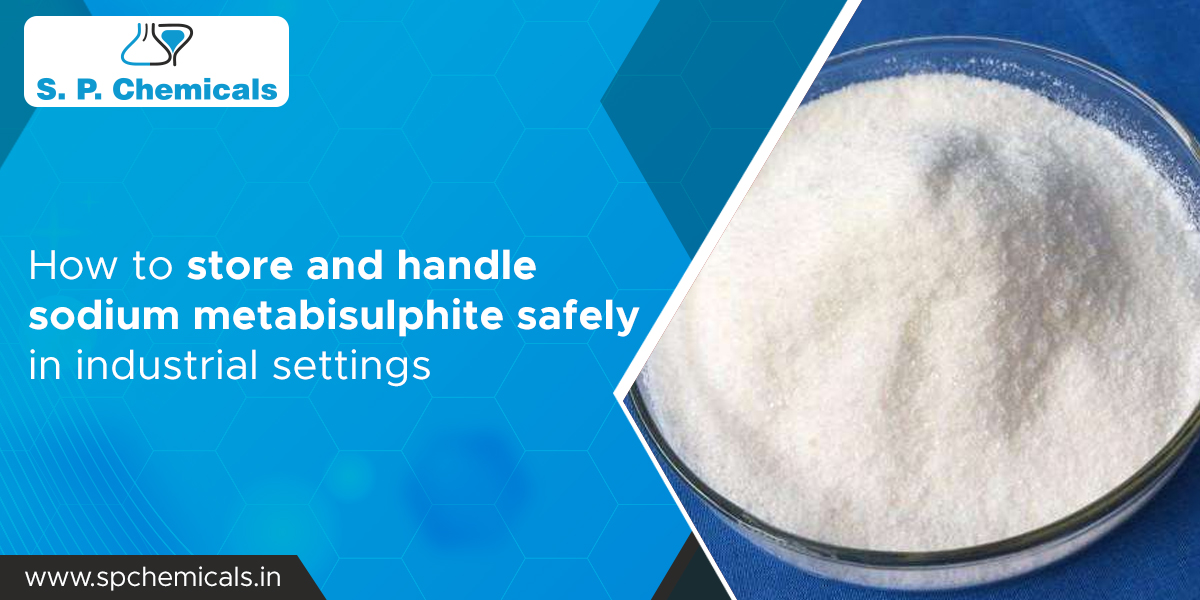
In industrial operations, precision and safety are non-negotiable, especially when dealing with powerful chemical compounds such as Sodium Metabisulphite/Metabisulfite. Known in the industry by other names such as Sodium Pyrosulfite/Pyrosulphite or Sodium Disulphite/Disulfite, this compound plays an indispensable role in water treatment, food preservation, photography, textile processing, and various manufacturing processes.
However, the same properties that make Sodium Metabisulphite Powder highly effective also require strict adherence to safe storage and handling practices. Mishandling can compromise both product quality and workplace safety. As the Trusted Sodium Metabisulphite Manufacturer In India, S.P. Chemicals prioritizes not only delivering top-quality products but also guiding industries in managing them responsibly.
This detailed guide outlines how to store and handle Sodium Metabisulphite/Metabisulfite safely in industrial environments, ensuring maximum efficiency while keeping people, processes, and products protected.
A Brief on the Nature of Sodium Metabisulphite/Metabisulfite:
Before diving into safety practices, it is crucial to understand the compound itself. Sodium Metabisulphite/Metabisulfite (Na₂S₂O₅) is a white or slightly yellow crystalline powder with a pungent sulphur dioxide odour. It is highly soluble in water and reacts strongly with acids, releasing sulphur dioxide gas. Its versatility makes it a staple in numerous industries:
With such wide-ranging applications, the need for proper storage and handling becomes even more significant.
Best Practices for Storing Sodium Metabisulphite:
The storage location is your first line of defence. Select a cool, dry, and well-ventilated space away from direct sunlight and heat sources. High temperatures can accelerate decomposition, while moisture can cause the powder to clump or degrade.
Always store Sodium Metabisulphite Powder in areas away from incompatible substances such as acids and oxidising agents. Mixing or accidental contact can trigger hazardous chemical reactions.
The packaging should be airtight and moisture-resistant. Commonly, Sodium Disulphite is supplied in high-quality HDPE bags, fibre drums, or multi-wall paper sacks with inner liners.
Once opened, containers must be resealed immediately to prevent exposure to air and humidity, which can reduce their effectiveness.
Every container should be marked with the chemical name, hazard symbols, and handling instructions. This prevents confusion, especially in facilities storing multiple chemicals.
Prolonged storage can impact product quality. By using the FIFO method, older batches are used before newer ones, reducing the risk of spoilage.
Safe Handling Guidelines:
While storage ensures long-term integrity, correct handling safeguards workers during daily operations.
When working with Sodium Pyrosulfite, always use suitable PPE:
Sodium Metabisulphite can form fine dust that may cause respiratory irritation. Use gentle handling methods, such as controlled pouring, and avoid shaking or dropping bags from a height.
Whether transferring, mixing, or measuring Sodium Metabisulphite Powder, always work in spaces with adequate airflow. Ventilation not only disperses fumes but also maintains a safe working environment.
Skin or eye contact can irritate. If accidental contact occurs:
When dissolving Sodium Disulphite/Disulfite in water, always add the powder to water, never the other way around. This minimises the risk of uncontrolled reactions or splashes.
If acids are part of the process, keep them completely separate until required, and handle them according to strict safety protocols.
Emergency Preparedness:
Even with the best practices in place, unforeseen incidents can occur. Preparation is key.
1 Spill Management:
For minor spills:
While Sodium Pyrosulfite/Pyrosulphite itself is not combustible, it can release sulphur dioxide fumes when heated. Keep it away from fire hazards and have appropriate fire extinguishers (dry chemical powder or CO₂) readily available.
Workers handling Sodium Metabisulphite should be trained in first aid, particularly in recognising and responding to inhalation or contact-related symptoms. Rapid intervention can prevent more serious health effects.
Maintaining Quality Through Proper Storage and Handling:
The chemical efficacy of Sodium Metabisulphite Powder depends heavily on how it is stored and handled from the moment it leaves the manufacturer until it is used. Moisture, heat, and contamination are its biggest threats.
By maintaining sealed, clearly labelled containers in dry, ventilated spaces, and by ensuring your workforce is well-trained, you not only protect the product but also safeguard your production processes.
Why Partner with the Trusted Sodium Metabisulphite Manufacturer in India?
S.P. Chemicals is more than a supplier; we are an industry partner committed to delivering Sodium Metabisulphite/Metabisulfite of the highest quality while equipping our clients with the knowledge to store and handle it safely.
Our product range, including Sodium Pyrosulfite and Sodium Disulphite, meets stringent quality benchmarks and is packaged to ensure maximum shelf life. Every batch undergoes rigorous quality checks, and we provide complete technical guidance to support safe usage across industries.
When you source from S.P. Chemicals, you are not just buying a chemical; you are investing in reliability, compliance, and performance.
Final Thoughts:
Safe storage and handling of Sodium Metabisulphite is not just a regulatory requirement; it is a business imperative. Improper practices can lead to degraded product quality, workplace hazards, and operational inefficiencies.
By implementing the recommendations in this guide and by partnering with a Trusted Sodium Metabisulphite Manufacturer in India like S.P. Chemicals, you ensure that your operations run smoothly, safely, and in compliance with the highest industry standards.
Safety and quality go hand in hand, and with the right approach, you can achieve both without compromise.